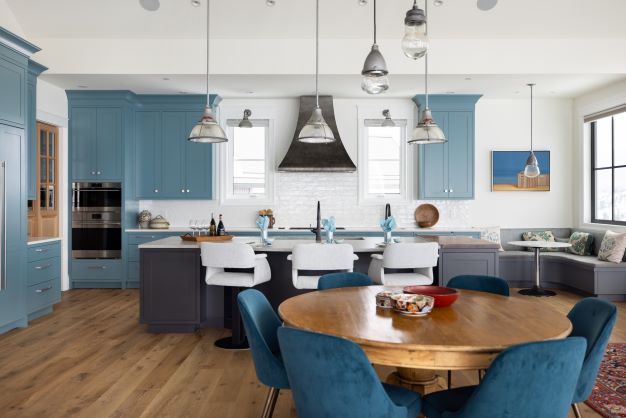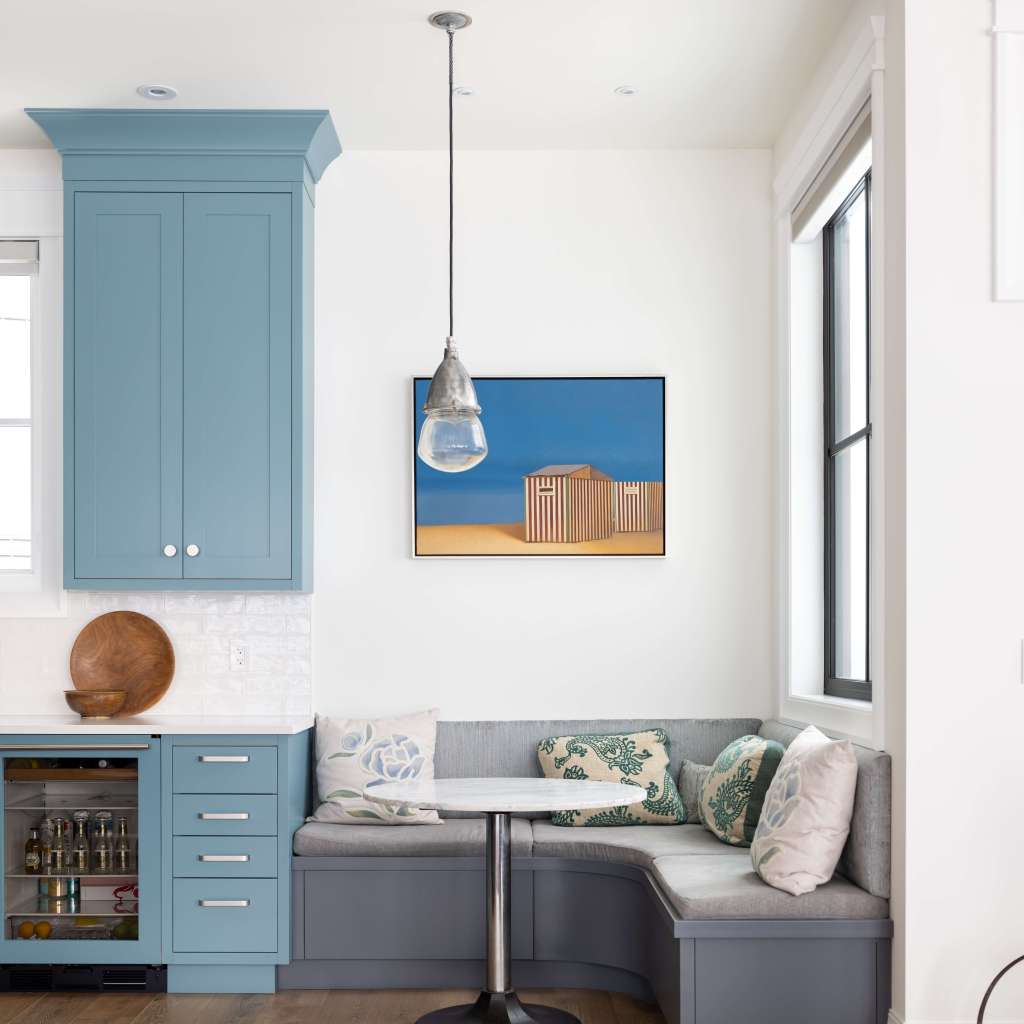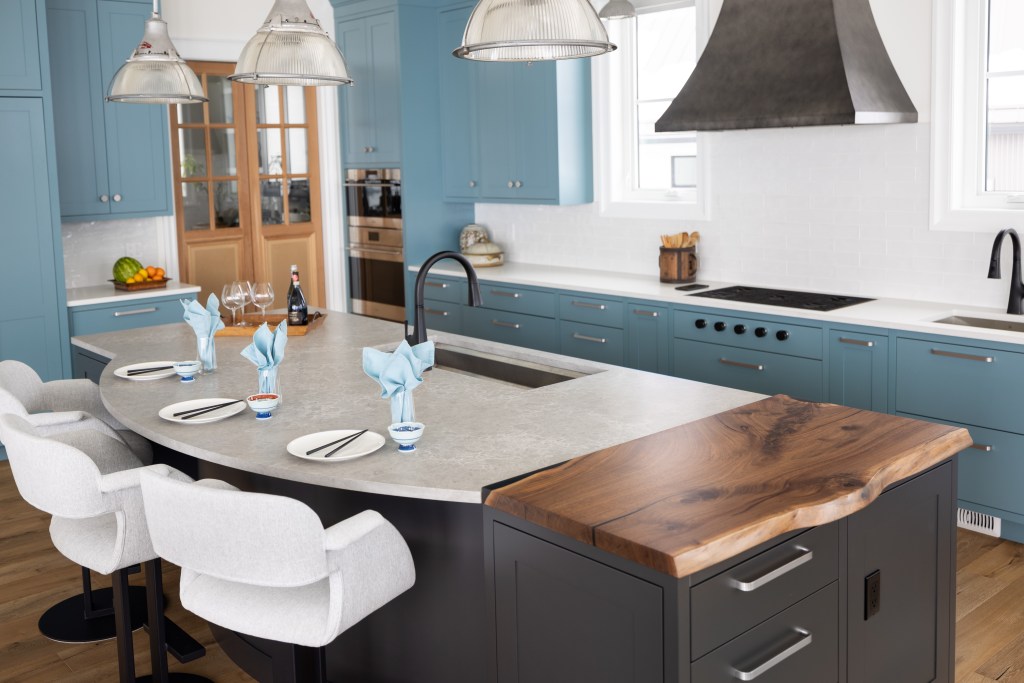Most homeowners thinking about a new kitchen immediately start collecting images of how the space will look. The lure of shiny quartz counters, pro appliances and modern cabinet doors are hard to resist.
It becomes the responsibility of the Kitchen Designer to help them take a step back and focus on the function of the space to produce the best possible design.
This does not mean that aesthetics do not matter because they do, but a kitchen that doesn’t function will never be a client’s dream kitchen.
Understanding the theory of Kitchen Zones or Food Flow will help you design a winning kitchen for your client.
Using the concept of Kitchen Zones will produce the most functional design for your client. It approaches Kitchen Design based on how food flows through the kitchen.
This concept entails locating five essential zones into each kitchen design.
The 5 Essential Kitchen Zones

- The Food Storage Zone
- The Prep Zone
- The Cooking Zone
- The Serving Zone
- The Clean-up Zone
Each one of these zones needs to be included in a functional kitchen design to ensure the kitchen can be used for its main purpose:
Dealing with Food!

Farmer’s Market Root Vegetables 
Produce at the Super Market
The first step in the design process is to identify appropriate locations for each zone. A good rule of thumb is to try and place them in sequence.
The best way to do this is to envision your client moving through the space preparing a typical meal like this:
- Gathering food from the refrigerator and pantry (Food Storage Zone)
- Moving food to an area to be prepared (Prep Zone)
- Transferring to the range or cooktop for cooking (Cooking Zone)
- Placing food to be eaten in the eating area (Serving Zone)
- After the meal is finished deal with the dishes and leftovers (Clean-up Zone)
Roughly sketch this onto your floorplan and then you are ready to detail each Zone.
Let’s look at what each Zone entails and needs to have.
The Food Storage Zone

Pullout Pantry & Paneled Refrigerator 
Built in Fridge & Duel Pantries
The Food Storage Zone is for the storage of refrigerated and non-refrigerated food.
To make unloading groceries easier, locating a pantry system near the refrigerator makes a lot of sense. The pantry can be a cabinet with internal accessories or a walk-in one with shelves.
Base and upper cabinetry can also store dry goods. Adding extra shelves in the upper cabinetry and equipping the base cabinets with rollouts can accommodate most food storage needs.
The refrigerator will always house the fresh produce that needs to be cooled, but non-refrigerated fruits and vegetables also need a dedicated storage space.
Storage solutions that allow non-refrigerated items to “breath” is the best solution. Many cabinet accessory manufactures produce woven root baskets that pull out of a base cabinet and are perfect for this type of storage.
The Prep Zone

Island Prep Zone with round sink 
Prep Zone with utensil insert & lower counter
The Prep Zone should include a minimum of 3′ of continuous countertop with a water source nearby.
This is the area where food is prepared by cleaning it, chopping it and/or mixing it.
Storage in this area needs to accommodate knives, cutting boards, utensils, small tools, mixing bowls and some small appliances. Interior cabinet accessories are available to organize all of these items in the prep zone.
Adding a prep sink to your design can free up the main sink for clean-up activities.
There are a variety of shapes and sizes of prep sinks on the market and often they are available with built-in colanders and cutting boards to streamline food preparation. You can check out our ICON course How to Specify a Prep Sink for your Client for more information on Prep Sink selection.
Specifying a lower counter in the prep zone can also add function to the space. Prep activities such as mixing and rolling out dough can benefit from a lower counter surface.
The Cooking Zone

Cooking Zone Niche 
Cooking Zone with Cooktop
The Cooking Zone revolves around the range.
Good ventilation is always a must for this zone along with specialized storage for cooking equipment.
Even though most food should be stored in the Food Storage Zone it is best to store your oils, vinegars and spices in the Cooking Zone. A condiment pullout is the perfect interior cabinet accessory for these items.
Pots and pans should also be stored in this area and can be accommodated in deep drawers or rollout shelves.
In designs where the cooktop and oven are separated, the cooktop becomes the center of the Cooking Zone with the added bonus of storage below the appliance.
The Serving Zone

Double Plate Racks Serving Area 
Dish storage cabinet to countertop 
Narrow serving zone storage
Once the food is cooked it needs to be transferred to the dining area. This can be at a dining table or dining bar.
The Serving Zone is where all the tableware should be stored.
Planning a Serving Zone away from the main work zones in the kitchen allows a helper to be in the kitchen, setting the table without interfering with the main cook.
Glass door cabinets or floating shelves are a nice touch for dinnerware storage and can add a decorative element to the space.
Bringing your upper cabinetry down to the countertop can make accessing tableware easier so even the children can help set the table.
The Clean-up Zone

Clean-up zone with Raised Dishwasher 
Clean-up Zone with recycle centre
Clean-up at the end of a meal for most people is an unwelcome activity.
By designing an efficient Clean-up Zone this chore can be accomplished efficiently and swiftly.
The Clean-up Zone at a minimum needs to have a main sink and a dishwasher. Adding a trash/recycling center will take this zone to the next level.
Little details like under-mounting the sink in the counter allows for quick wiping down of the counters with no ledge to trap dirt or crumbs.
Installing a trash can on a cabinet door that flips up the lid when opened will also save time.
Plan all your Kitchens using Food Flow
Kitchen Zoning for optimum food flow is the best way to ensure you plan the most functional space possible for your clients.
The system works for large multi-cook spaces and one cook kitchens.
By including each of the kitchen zones in your kitchen designs, you will have a functioning space that will truly make it your clients dream kitchen!
VESTABUL SCHOOL OF DESIGN has a CORNERSTONE course called The Beginners Guide to Kitchen Design that educates individuals new to Kitchen Design or just starting their career in Kitchen Design . It will teach you everything you need to know about Kitchen Design Theories and more!

Jan Rutgers is a Professional Kitchen Designer with more than 25 years experience. During her career she has designed over 1000 kitchens, learning valuable skills with each one! She is the founder of VESTABUL SCHOOL OF DESIGN, where she educates and mentors people passionate about the Kitchen Design Industry.






Pingback: Everything You Need To Know About the Food Storage Zone – VESTABUL SCHOOL OF DESIGN
Pingback: Everything You Need to Know About the Kitchen Prep Zone – VESTABUL SCHOOL OF DESIGN
Pingback: Everything You Need to Know about the Kitchen Clean-Up Zone – VESTABUL SCHOOL OF DESIGN
Pingback: How F.R.E.S.H Are Your Kitchen Designs? – VESTABUL SCHOOL OF DESIGN
Pingback: Banishing the Cookie-Cutter Kitchen Island! – VESTABUL SCHOOL OF DESIGN
Pingback: Case Study: Appliances at the Willow Project Part 2 – VESTABUL SCHOOL OF DESIGN
Pingback: How-to-design-a-FRESH-kitchen
Pingback: The-transformative-power-of-good-kitchen-design